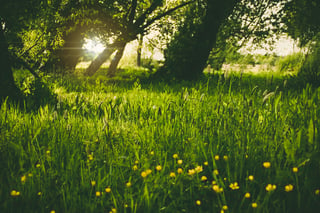There are some diseases and some insects that only go for either warm-season grasses or cool-season grasses, and then there are some that don’t really have a preference  and will take whatever they can get as long as the conditions are right. Pythium blight is one of those fungi that doesn’t particularly care. So what is this blight that can cause problems for you in your yard? Here are some tips to identifying it, preventing it, and controlling it.
and will take whatever they can get as long as the conditions are right. Pythium blight is one of those fungi that doesn’t particularly care. So what is this blight that can cause problems for you in your yard? Here are some tips to identifying it, preventing it, and controlling it.
For starters, although we call it a fungi, it isn’t a true fungus as it is biologically more similar to an algae than a fungus. Not that many homeowners care a whole lot about the biological makeup of the disease or fungi that is infecting their lawn. The importance comes from allowing a better understanding of how to manage the problem.
Pythium blight is an interesting fungi in that it doesn’t just kill off patches of grass or cause it to look dead, instead what you are looking for are small irregular shaped patches that develop a purple or red-like hue. The infected patches may look wet and feel slimy as well. After some time, you may notice the discoloration spreading with water flows as the pathogen that causes this turfgrass infection is washed around the yard. As the disease progresses, you may notice those once purple-ish patches begin to turn a straw color or look somewhat bleached.
The turfgrass leaves may begin to stick together because of their slimy nature after being infected. In the mornings or after long hours of the grass being wet, you may also notice a strange, cottony looking growth in the affected areas. This is mycelium that is growing from the pathogen. Because of this aspect of the disease, pythium blight is also known as cottony blight. You may have also heard it called greasy spot or water mold, as these characterize other aspects of the infection.
So what can you do if you notice these signs and symptoms developing in your yard? The best thing to do is use preventative measures, such as proper watering and irrigation methods, ensure proper drainage for your lawn, and managing appropriate nitrogen levels in your soil. There are fungicides that can be used to control pythium blight but should be done appropriately and with professional advice as some fungicides can increase the likelihood of helping the blight become resistant to fungicides.
If you need help with your lawn give Greenfeet Lawncare a call or Click the link below for a Free Estimate.
Greenfeet Lawncare Provides Service to the Following Areas
770.619.2929
North Fulton, East Cobb, Cherokee, Forsyth Counties - including Alpharetta, Canton, Cobb, Cumming, Dunwoody, Gwinnett, Johns Creek, Marietta, Milton, Roswell, Sandy Springs